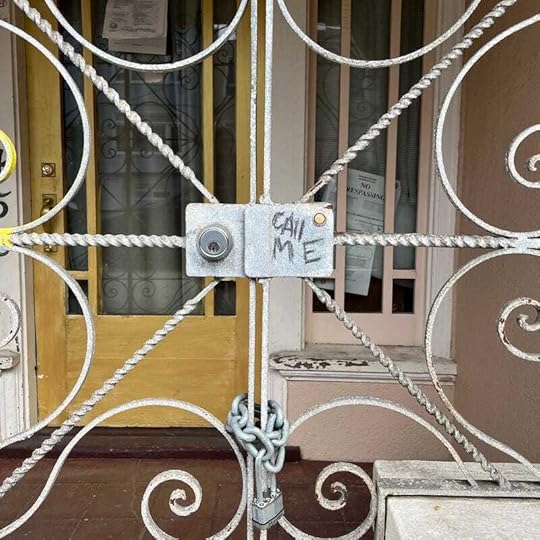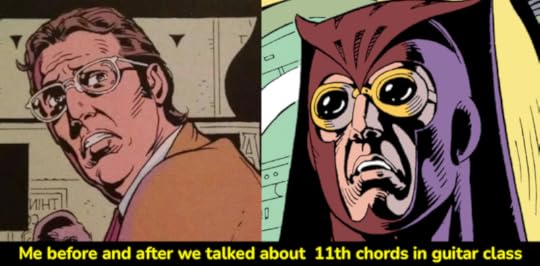Marc Weidenbaum's Blog, page 89
October 3, 2023
My Luggage Store Review from The Wire
This is a slightly edited version of my concert review that appeared in the October 2023 (Issue 476) edition of The Wire magazine.
Ross Hoyt/Leila Abdul-Rauf/Ryan Honaker/Ed Lloyd + Cecyl Ruehlen + Michael P Dawson + San Kazakgascar
Luggage Store Gallery, San Francisco, US
July 5, 2023
The Luggage Store Gallery on Market Street sits a few doors down and a few flights up from a corner, at Sixth Street, that veered toward dissolute long before the pandemic turned cities into targets for end-times rhetoric. The interior stairwell is festooned with scrawl and stickers, visual chaos that channels the exterior urban disorder into something willfully beautiful. You emerge, after a climb, into the stark space of a single large room. At one end, floor to ceiling windows would overlook the street were the glass not lightly frosted.
The Luggage Store Gallery New Music Series takes place there nearly weekly, programmed by Outsound Executive Director Rent Romus, who lends context to experimental acts by coordinating — or simply creating a sympathetic venue for — shared themes, approaches, vibes. On a seasonally cool Wednesday night after U.S. Independence Day, four sets manage to explore expressly different corners of ambient drone music with a touch of noise. Each of the first three creates a moment that concentrates its unique capacities.
First comes the quartet of Leila Abdul-Rauf (trumpet), Ryan Honaker (guitar), Ross Hoyt (keyboard), and Ed Lloyd (double bass). For them, the key moment is when Abdul-Rauf switches, after the midpoint, from electronically mediated trumpet, à la Arve Henriksen or Nils Petter Molvær, to intoned voice — and the band don’t miss a beat. Their consummate ambient chamber jazz allows for a shifting of source materials, including some found vocals and even an exclamatory shout from Hoyt.
For Cecyl Ruehlen, a fantastic saxophonist who performs through and along with a synthesizer rig, the moment is when a certain stratagem solidifies. There is a gating effect underway, a man-machine sidechain by which his horn, when loud enough, pushes the synth down in the mix. When he rests for a moment, the synth comes back strong, only to subside again when he next blows. Combined with Ruehlen’s effortful breathing, this method lends vibrancy to the synth, positing it as a natural force unto itself.
Michael P Dawson’s moment occurs when he simply stands up. He initially sits with a tiny modular synth box in his lap, coaxing muted signals patiently with a professorial demeanour. Quite suddenly, he rises, places the box on his seat, walks toward the audience and recites poetry. Instantly, the sounds the audience had focused on become background music, a setting for his recitation. It’s WB Yeats’s “The Song of Wandering Aengus” — the poem from which, back in the late 1960s, Morton Subotnick borrowed the title Silver Apples of the Moon. Later those same words emerge, fragmented, from Dawson’s instrument.
The final act, San Kazakgascar, take on the role of drone band. They launch with a single such clarifying moment, a textural tone — then seek to hold it in reverberant stasis as long as possible. Tonight the members of this ever-shifting ensemble are guitarist Jed Brewer (guitar), Kevin Corcoran (percussion), Rachel Freund (clarinet), Greg Hain (synth), Colleen Kelly (six-string electric cello), Matt Kretzmann (synth), James Jaroba Barnes (bass clarinet), and Brian Lucas (guitar). The most impressive result from a large drone band is to hear more musicians producing seemingly less music. By those standards, tonight is a major, if at times loud, accomplishment.
October 2, 2023
More 30-Second Audio-Visual Field Recordings

I’ve been enjoying using the Story mode on Instagram to post brief (30-second) audio-visual field recordings with light annotation. An Instagram Story is simple to produce, meaning (1) the dreaded modern sense of unpaid labor is minimal (as long as you don’t overdo it), and (2) they sync with my phone (without an Instagram logo), so they’re reusable elsewhere (though I tend to repost them without the tags and other text elements). Those are still frames from my most recent two above. The one on the left was recorded during Golden Hour in Berkeley, the first time I attended an event at the Alembic, and the one on the right was shot in the bathroom of a take-out joint in the North Bay: two very different drones, both abrasive, one outdoors, one indoors. They’re part of my “30s” (or “30 seconds”) Highlights series at instagram/dsqt, and the raw videos are on YouTube (golden hour and bathroom). (Collections of Instagram Stories are called Highlights.) Interestingly, if you upload short vertical videos to YouTube, they automatically get filed as Shorts, which is YouTube’s attempt at Instagram Stories.
October 1, 2023
On Repeat: KMRU, Tasselmyer, Demo, Incense
I try to at least quickly note some of my favorite listening from the week prior — things I’ll later regret having not written about in more depth, so better to share here briefly than not at all.
▰ More on this release shortly, likely in the coming week, but I am really enjoying Kenyan musician KMRU’s new album, Dissolution Grip, which somehow does away with his trademark field recordings without losing their influence. The key — or legend, in this case — is the notion of a graphic score. Check out the liner notes for an explaination.
https://kmru.bandcamp.com/album/dissolution-grip
▰ Andrew Tasselmyer (from Baltimore, based in Philadelphia) plays with time in delectable ways. Listen (and watch) as he samples, slices, fractures, and delicately reconfigures piano recordings.
▰ More music technology could use examples, like this one, that you go back to listen to simply because the sounds are so pleasing. This half-hour survey of slowly emerging melodic and rhythmic elements is a demo of a “conceptual sequencer” — called Seqsual — for the iPad. It’s from Helsinki, Finland.
▰ There is atmospheric music, and there is kosmiche (or space) music, and somewhere in between is music that seems to float in the realm of satellites, the ionosphere. This is the realm of Simon James French’s recent album, Meditations: ionospheric music, all euphoric-yet-sedate sonic explorations. Apparently there’s a line of Japanese incense created to complement it. French splits his time between Japan and the U.K.
September 30, 2023
Scratch Pad: Weird Alarm, Audiobook Synchronicity
I do this manually at the end of each week: collating (and sometimes lightly editing) most of the recent little comments I’ve made on social media, which I think of as my public scratch pad. I mostly hang out on Mastodon (at post.lurk.org/@disquiet), and I’m also trying out a few others. And I take weekends off social media.
▰ Numerous folks in the neighborhood peeking out their windows ’cause some car has the weirdest alarm going off, just plain peculiar — not just like they made it themselves, but like they didn’t even know what they were doing
▰ There are moments when an audiobook eerily aligns with with your current situation. As I walked home at dusk, I was informed by Alan Furst’s novel Dark Star of the Russian term “besprizorniye,” or “bands of children orphaned by the purge who attacked and robbed solitary walkers”
▰ I leave the amp on for a while after guitar class. My working theory is that the longer its hum lingers in the air, the longer before I forget half of what I’ve just learned.
▰ I certainly don’t want there to be a US government shutdown, but then again, if it meant we’d be spared the airborne noise of Fleet Week …
▰ Nice way to start the day: New York Times Wordle in 2 and Mini in :29. It’s kinda all downhill from here.
▰ Stop Making Sense is truly great. I saw the tour that became the movie (in Forest Hills) and I saw the film when it first came out and several times after, but in many ways that Rome concert on YouTube is the live Talking Heads I find myself going back to regularly and marveling at. And speaking of the Rome concert, we should all be fortunate enough to find someone in our lives who looks at us the way Tina Weymouth looks at Adrian Belew.
▰ Yow, it looks like the entirety of John Zorn’s Tzadik Records label is now on music streaming services. I’m listening to Quatrain, with guitarists Julian Lage and Gyan Riley, right now, after revisiting The Big Gundown. It’s Zorn’s 70th birthday, but listeners get the presents.
▰ Generally speaking Hardly Strictly festival traffic is chiller than Outside Lands festival traffic. It’s still traffic, and still noisy, but it’s a little more chill.
September 29, 2023
Music That Listens to Itself (Playlist)

I just got back home from the “Music That Listens to Itself” event that I hosted in Berkeley at the Alembic. Here, quickly, is the evening’s 80-minute playlist (I trimmed one track to get the full set to fit). The first six tracks came from the recent Disquiet Junto project (0611) that engaged with the theme of the evening. More details soon. I had a blast. Major thanks to Erik Davis, Samuel Plattner, and everyone who came. Each of the Junto tracks in the list links to its SoundCloud page, and each of the other six links to the album, on Bandcamp, where it originated.
1: “Music Itself Listens To” — Leon Clowes
2: “Lake in the Sky” — Dan Simpson
3: “gwrandewch” — wasabicube
4: “Don’t Get Lost” — xhg
5: “riemann loops” — caustic_gates
6: “Lesser Facets” — he_nu_ri
7: “The one that went with the film of the trees” — Marcus Fischer
8: “Circle II” — Jeannine Schulz
9: “Your Blind Passenger” — Stijn Hüwels
10: “Thursday Afternoon” — Dedalus Ensemble
11: “Searching for Shoals” — Karen Vogt
12: “Scattered” — The OO-Ray
You can also get to this post at disquiet.com/alembic2023.
September 28, 2023
The Bandcamp Conundrum
“I’m all lost in the supermarket / I can no longer shop happily”
I’ve been working on an essay about how broken modern consumer technology (software and hardware) is when it comes to downloadable files, like MP3s and FLAC. And then Bandcamp.com, a leading retailer of DRM-free audio files and a cultural force in independent music, goes and gets re-sold by the company that bought it just last year. Bandcamp began as a self-owned entity, then it was bought by Epic, the video game company, and now it’s been sold to Songtradr, a music licensing firm. The word “precarious” has been floating around in my imagination all day.
Let’s be clear: companies get bought and sold every day. That is business. But for musicians and music fans alike, Bandcamp plays a special role. Its social tools are quite minimal; it makes no claims to be, say, the internet’s town square. But if there even is such a thing as the internet’s town square, then Bandcamp is the record store on the corner.
Disquiet Junto Project 0613: Test Drive

Each Thursday in the Disquiet Junto music community, a new compositional challenge is set before the group’s members, who then have just under five days to upload a track in response to the assignment. Membership in the Junto is open: just join and participate. (A SoundCloud account is helpful but not required.) There’s no pressure to do every project. It’s weekly so that you know it’s there, every Thursday through Monday, when you have the time and interest.
Deadline: This project’s deadline is the end of the day Monday, October 2, 2023, at 11:59pm (that is, just before midnight) wherever you are. It was posted on Thursday, September 28, 2023.
Tracks are added to the SoundCloud playlist for the duration of the project. Additional (non-SoundCloud) tracks appear in the lllllll.co discussion thread.
These following instructions went out to the group’s email list (at tinyletter.com/disquiet-junto).
Disquiet Junto Project 0613: Test Drive
The Assignment: Do something you’ve been meaning to do.
Step 1: Think of something related to making music that you’ve been meaning to finally get around to.
Step 2: Do it. Don’t worry about messing up.
Note: The image is from: https://en.wikipedia.org/wiki/File:B11112P009.jpg
Eight Important Steps When Your Track Is Done:
Step 1: Include “disquiet0613” (no spaces or quotation marks) in the name of your tracks.
Step 2: If your audio-hosting platform allows for tags, be sure to also include the project tag “disquiet0613” (no spaces or quotation marks). If you’re posting on SoundCloud in particular, this is essential to subsequent location of tracks for the creation of a project playlist.
Step 3: Upload your tracks. It is helpful but not essential that you use SoundCloud to host your tracks.
Step 4: Post your track in the following discussion thread at llllllll.co:
https://llllllll.co/t/disquiet-junto-project-0613-test-drive/
Step 5: Annotate your track with a brief explanation of your approach and process.
Step 6: If posting on social media, please consider using the hashtag #DisquietJunto so fellow participants are more likely to locate your communication.
Step 7: Then listen to and comment on tracks uploaded by your fellow Disquiet Junto participants.
Step 8: Also join in the discussion on the Disquiet Junto Slack. Send your email address to marc@disquiet.com for Slack inclusion.
Note: Please post one track for this weekly Junto project. If you choose to post more than one, and do so on SoundCloud, please let me know which you’d like added to the playlist. Thanks.
Additional Details:
Length: The length is up to you. Maybe length is, in fact, something you’ve been meaning to experiment with.
Deadline: This project’s deadline is the end of the day Monday, October 2, 2023, at 11:59pm (that is, just before midnight) wherever you are. It was posted on Thursday, September 28, 2023.
Upload: When participating in this project, be sure to include a description of your process in planning, composing, and recording it. This description is an essential element of the communicative process inherent in the Disquiet Junto. Photos, video, and lists of equipment are always appreciated.
Download: It is always best to set your track as downloadable and allowing for attributed remixing (i.e., a Creative Commons license permitting non-commercial sharing with attribution, allowing for derivatives).
For context, when posting the track online, please be sure to include this following information:
More on this 613th weekly Disquiet Junto project, Test Drive (The Assignment: The Assignment: Do something you’ve been meaning to do), at: https://disquiet.com/0613/
About the Disquiet Junto: https://disquiet.com/junto/
Subscribe to project announcements: https://tinyletter.com/disquiet-junto/
Project discussion takes place on llllllll.co: https://llllllll.co/t/disquiet-junto-project-0613-test-drive/
September 27, 2023
September 26, 2023
Upcoming on Hilobrow: Proto-Punk

I’m very excited to have a short piece on Ornette Coleman in this upcoming online series at hilobrow.com about “proto-punk records from the Sixties (1964–1973).” And what a lineup of contributors, including Stephanie Burt, Jonathan Lethem, Lucy Sante, and Mike Watt. When I was invited to contribute, my initial idea was to write about “Excursion on a Wobbly Rail” by jazz pianist Cecil Taylor, because I’d read that its title was used by the Velvet Underground’s Lou Reed as the name of his radio show on WAER 88.3 FM (at Syracuse University in New York), but that track wasn’t in any evident way “punk,” and it came out too early to slot into this Hilobrow conceit (1959 — it closed out his Taylor’s sophomore record as a leader, Looking Ahead!). I’d also read about Reed’s affection for Ornette Coleman around the same time, and then this track came to mind. My piece will be out in maybe a couple months?
September 25, 2023
Call Me

These miniature photo essays on doorbells that I’ve now been writing for years, perhaps a decade if not longer, tend toward the neutral. The subjects are mundane, and they are purposefully so. That is what catches my eye, and my imagination. Often what makes the images — and their subjects — interesting to me is less the human factor than what the elements have brought to bear. Then again, what the elements have done reflects, generally, a lack of concern on the part of humans — lack of concern itself being a human factor, perhaps a defining human factor. Taking no action, making a poor decision, not planning ahead — these are themselves examples of agency.
Every once in a while, though, there’s clearly a different sort of human factor at play. The “call me” seen here expresses an act of desperation, one that is unfamiliar from all the doorbells I’ve studied or, for that matter, glanced at over the years. Each letterform here is the result of multiple layers of scrawl, an emphatic cry; to see the letters is to hear the scratching. And if the urgency of the writing isn’t evidence enough, then the paperwork in the background — the trespassing notice, the additional material taped to the front door, the image of a municipal seal — along with the heavy chain and lock says that something life-altering has occurred.
A doorbell, at its most basic level, is a means for someone outside a home, or business, to send an audible signal to someone inside a building. Occasionally a doorbell will include some form of writing, in addition to an address or apartment number, often affixed with tape to a gate or door — such as instructions to delivery services, or a note that the bell itself has ceased functioning. Circumstances here, however, have turned a doorbell into a platform for communication in the opposite of its normal, intended direction — not a loudspeaker, more a bulletin board. Here, in stark contrast with mundane daily life, the doorbell has been repurposed by someone who has been removed from their home, and who needs to get a message out.




